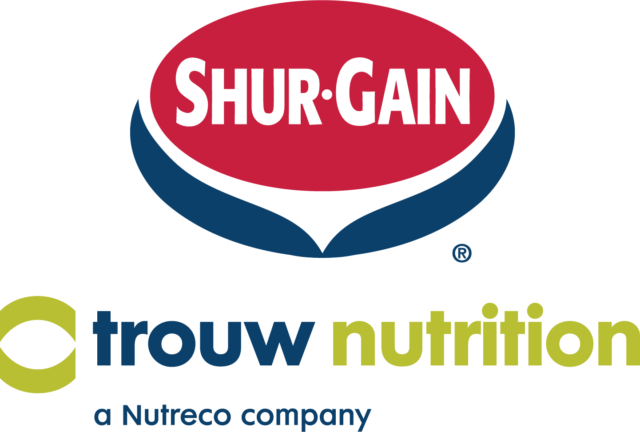Cows are designed to use forage. It keeps them productive and healthy. Forage quality sets the limits for how much forage we can feed and the ceiling on how well animals can perform. We include as much in rations as we can while making sure nutrient requirements are met and cows are healthy.
And everyone knows you can only do this with high-quality forage, right?
But wait a minute ... then why do a lot of dairy farms feed straw to their milking herd? There’s no way straw qualifies as high-quality forage. Maybe we need to change the discussion from “high quality” to “right quality” and discuss what we need forages to do.
Forages do two very important things in the ration:
- The digested part of forage provides nutrients to the cow.
- The large particles, the physical form of forage, maintain healthy rumen function.
So for the cows, we need forages that are digestible enough to provide nutrients and have the right physical form. But what happens if the only forage you have is a 25 percent protein, 35 percent neutral detergent fiber (NDF), high-digestibility alfalfa silage? Or a 40 percent starch, 35 percent NDF corn silage?
They may be very high quality on the digestibility and composition side, but they won’t provide enough fiber to keep the cow healthy. Think of them as the equivalent of an all-cheesecake diet. What forages would you add to keep cows healthy? This is where straw, grass or some higher-fiber forage might come into the ration, even though we’d call them lower-quality.
When we talk about forage quality, we should probably talk about right quality instead of high quality. Right quality includes how well a feed complements the rest of the ration to meet the cows’ needs. It takes into account the need to balance the whole ration.
As we strive toward the right quality of forages for our rations, the forage characteristics we need to consider are physical form, composition, digestibility and amount.
Physical form
Physically effective fiber is key to allowing rations to work well. It describes the physical form of the forage that increases cud chewing, maintains good rumen function and reduces the risk of ruminal acidosis.
It can form a mat in the rumen that acts to retain feed particles so they can be fermented by microbes, while the smaller fragments of broken-down fiber may help to move feed and microbes out of the rumen. Two keys to a physically effective fiber source include:
-
Particle size: Larger particles encourage more rumination than smaller particles … but only if the cows eat them. Particles 1 to 2 inches long in a moist, hard-to-sort ration work well.
-
Digestibility: A forage with more slowly and less extensively fermentable fiber – think straw – will be more effective than the same amount and particle size of a rapidly and more extensively fermented fiber because it will stay in the rumen longer to encourage rumination.
- Additionally, the density, hydration and fragility of the particles can also have effect.
Although we do use shaker boxes to see what profile of particles we’re offering to the cow, we still do not have a complete system to tell whether we’re providing enough physically effective fiber. The cows are the only ones that can judge this. You need to walk out among the cows and check:
- Cud chewing: 50 percent of all animals not sleeping, eating, drinking or in heat should be chewing their cuds. In heat stress, the percentage may be 5 to 10 percent lower, but that may also mean you need to cool the cows.
- Manure: no diarrhea or very loose manure. The great majority of particles in rinsed manure should be no longer than a half-inch. Long particles in the manure mean that feed escaped the rumen too soon and was not properly digested (Figure 1).
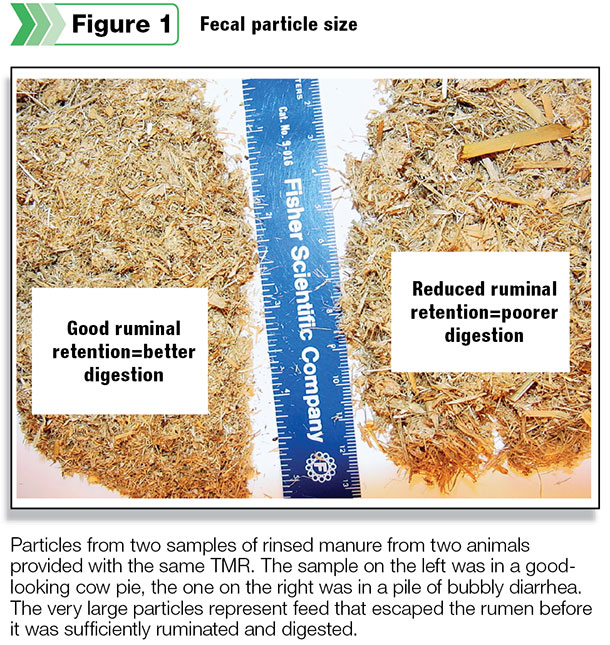 In a pen of animals all getting the same TMR, the manure should be 95 percent consistent. If not, see if the animals are sorting their feed. If animals are sorting, each animal may be getting a different ration, and their manure will be just as variable.
In a pen of animals all getting the same TMR, the manure should be 95 percent consistent. If not, see if the animals are sorting their feed. If animals are sorting, each animal may be getting a different ration, and their manure will be just as variable.
Composition
Composition is the basic information you get on your feed analyses that is the starting point for formulating rations. Dry matter percent, protein, NDF, energy, starch, water-soluble carbohydrate (includes sugars), fat, ash, minerals, etc.
The 2001 Dairy NRC has recommendations for how much total or forage NDF and non-fiber carbohydrate (NFC; sugars, starch, pectins, etc.) could be fed to support production and health (Table 1).
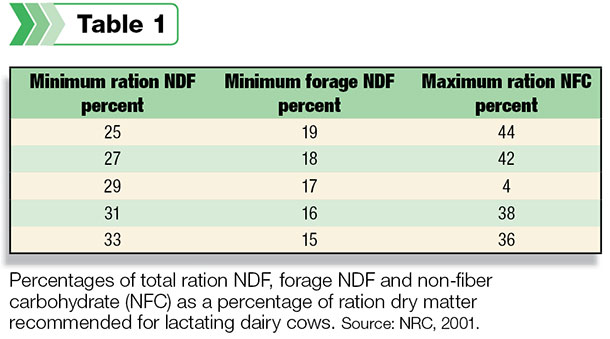
You’ll notice that as the percentage of forage NDF in the ration increases, so does the allowable amount of NFC. This gives credit to forage fiber for encouraging cud chewing and rumen buffering, which can counter the acid made by the microbes fermenting the NFC in the rumen and prevent ruminal acidosis.
Alternatively, Dr. David Mertens had recommended that forage NDF should provide approximately 75 percent of total NDF in the ration or 0.9 to 1 percent of a cow’s bodyweight.
We have long known that slowly digesting or indigestible parts of feeds can limit intake; there’s only so much mass a cow can fit into her gut. Considering that NDF is the least digestible part of the ration, we can use forage NDF to make a rough estimate of the limits on how much of a given forage you can feed (Figure 2).
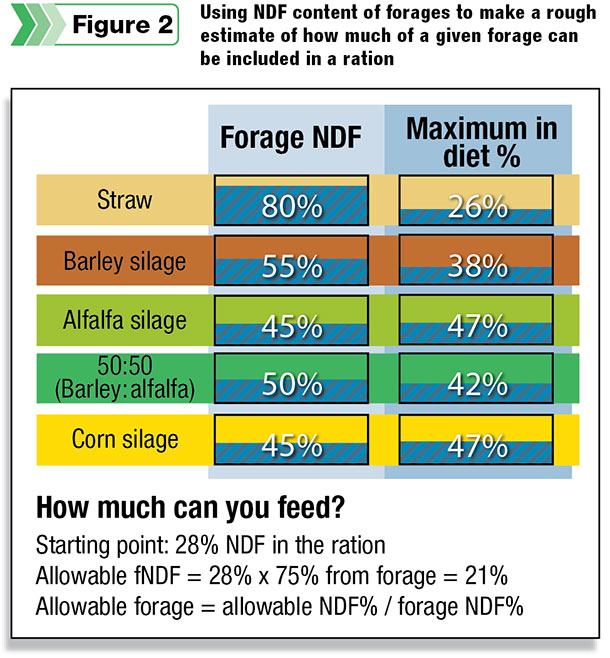
Take the percentage of NDF you want in the entire ration and multiply it by 75 percent to give the percentage of forage NDF to include in the ration. Then divide the result by the percentage of NDF in the forage to give the amount of forage you could feed. Very low-fiber forages can be included at higher levels than high- fiber forages.
Warning: These calculations don’t take fiber digestibility into account, and they don’t promise how much the cows will produce. But it does give a sense of how fiber content affects how much of a forage you can feed. And whatever you do, don’t feed spoiled or moldy feeds.
Digestibility
Forage digestibility affects protein and energy supply to the cow. We usually consider that most of the NFC (if the grain is properly processed and has the desired moisture content) and the protein are pretty digestible, so we focus on digestibility of the forage fiber. Neutral detergent fiber digestibility (NDFD), as measured by allowing rumen microbes to digest the fiber for 24, 30 or 48 hours, can give responses that vary widely by forage (Figure 3).
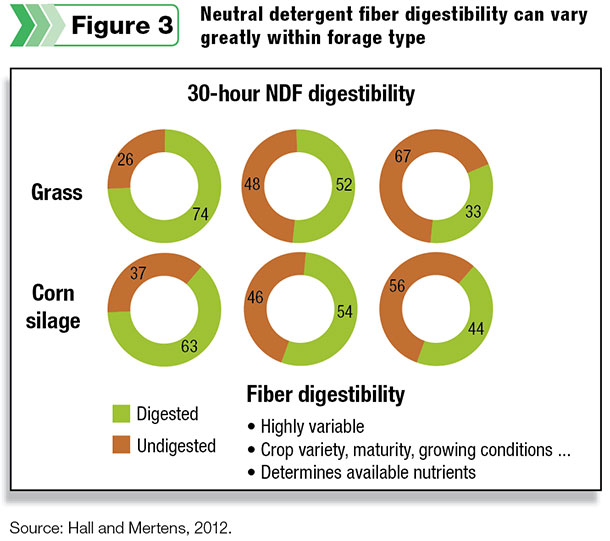 Greater digestibility means more energy available to the cow. The more digestible the forage, the more the cow will be able to eat because there will be less indigestible material taking up space in her rumen. If the forage fiber is very digestible, that may reduce time in the rumen so the forage will be less physically effective than a less digestible fiber of the same particle size.
Greater digestibility means more energy available to the cow. The more digestible the forage, the more the cow will be able to eat because there will be less indigestible material taking up space in her rumen. If the forage fiber is very digestible, that may reduce time in the rumen so the forage will be less physically effective than a less digestible fiber of the same particle size.
Fiber digestibility is a very useful tool for evaluating forages, but it’s not a scalpel. In analyses of NDFD that were properly run in a single laboratory, repeated runs on a single forage sample gave values that fell in about a 10 percent range 95 percent of the time. That’s about plus-or-minus 5 percentage units around a mean.
If you send the forage sample to multiple labs that run it multiple times, the range is about 13 percent, or plus-or-minus 6.5 percentage units around the mean. This is with labs doing a good job of analysis.
Forage NDFD is very useful for comparing forages and for adjusting energy values of forages, but it could not tell that forages were different unless they were more than 5 percentage units of NDFD apart.
Amount
Amount of forage is another aspect of quality. But only in the sense of that you need enough of the right-quality forages to feed your herd for the entire year.
What to do?
- Balance first with forages. They dictate the ration’s base. Build around that.
- Aim to meet cow fiber and nutrient needs within the bounds of present recommendations.
- Work with the cows to figure out the details.
References omitted but available upon request. Click here to email an editor.



